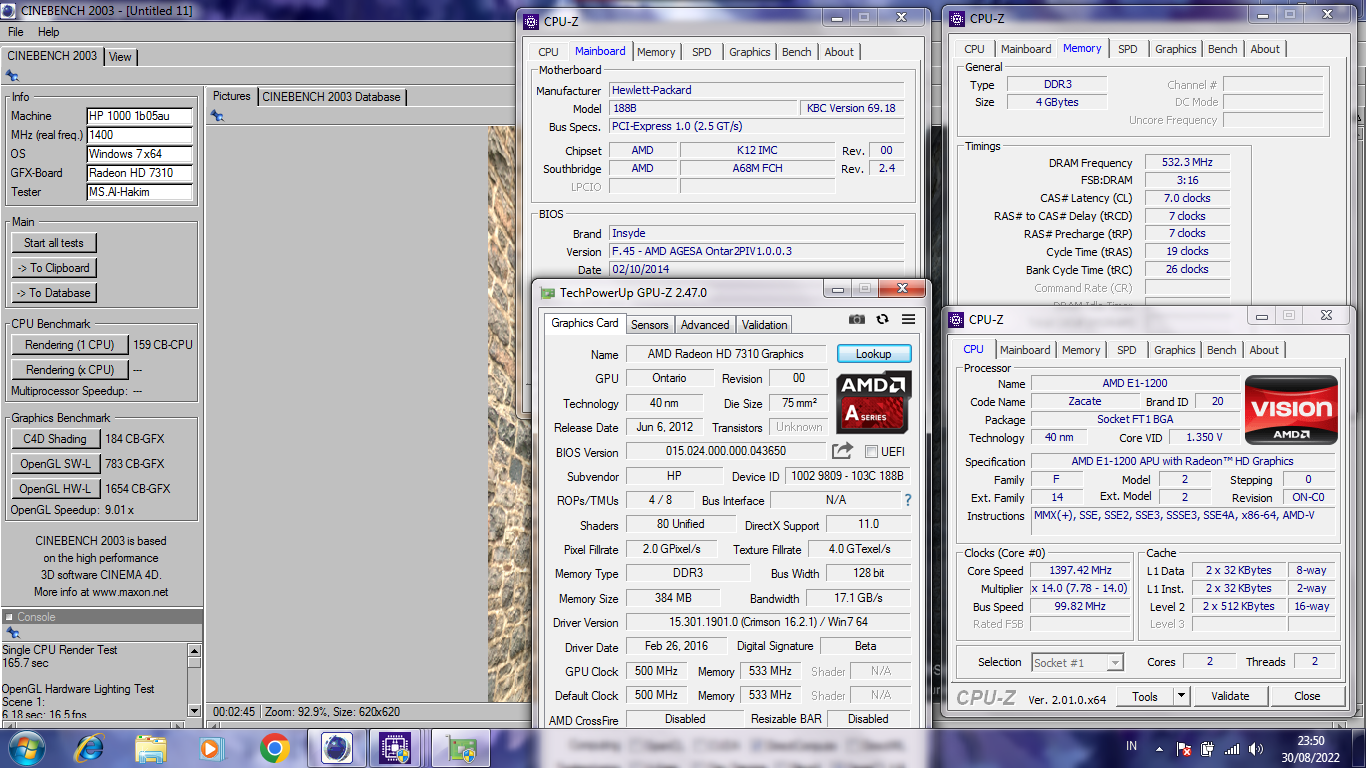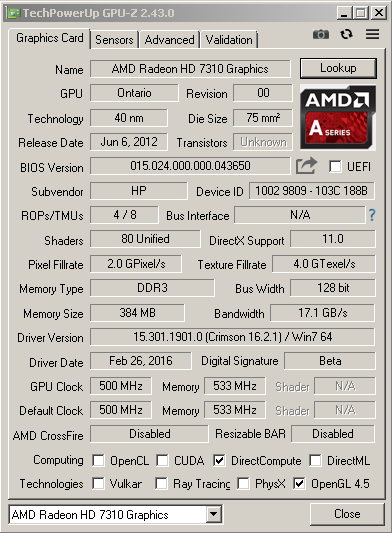Cinebench (GPU OpenGL) - 2003 HW-L score 1654 CB-GFX with a Radeon HD 7310
Thursday, 01 January 1970 07:00 | Update at null
Media Gallery
Screenshot

Device, Setup, etc



URL
https://bit.ly/3TrGKvfInformation Detail
Hardware: AMD Radeon HD 7310
Specs:Architecture : Terascale 2
Codename : Ontario
Chip : -
Core : 80
Memory : 384MB DDR3 (SHARED)
Bus Width : 128 bit
Core Clock : 500MHz
Memory Clock : 533MHz
TDP : -
Technology : 40nm
Bus Interface : Integrated
CPU: AMD E1-1200
See more specification...
Software: Cinebench (GPU OpenGL) - 2003 HW-L
Score: 1654 CB-GFX
About: Cinebench (GPU OpenGL) - 2003 HW-LCinebench (GPU OpenGL) - 2003 HW-L is one of the benchmark tests used to measure GPU performance in rendering 3D graphics using OpenGL, based on tests performed on hardware and software from 2003. The test is designed to test the GPU's ability to process graphical effects and render 3D objects using the older OpenGL standard, reflecting a lower level of visual complexity compared to modern graphics standards. At the HW-L (Hardware Level) in 2003, the main focus was on testing performance in processing polygons, lighting, shadows, and materials with simpler computations. This benchmark is still used by some users who want to compare modern systems with legacy hardware or test the compatibility of legacy hardware and software. The benchmark score is calculated based on the time it takes for the GPU to complete a series of rendering tests in OpenGL, where lower times indicate better GPU performance. Cinebench (OpenGL GPU) - 2003 HW-L is often used to measure GPU stability and performance on lower-spec systems or older hardware, as well as for benchmarking purposes between different generations of graphics cards.
The AMD Radeon HD 7310 is an entry-level integrated graphics processor (IGP) that is part of the AMD E1-1200 APU, launched in 2012 for budget-oriented laptops. Based on the Terascale 2 architecture, the Radeon HD 7310 features 80 stream processors (shaders) and runs at a clock speed of up to 500 MHz. While modest in terms of raw power, this GPU was designed to handle essential computing needs with minimal power consumption, making it ideal for ultraportable laptops and low-cost netbooks of its era.
The Radeon HD 7310 supports DirectX 11 and UVD3 (Unified Video Decoder) for smooth HD video playback, making it fairly capable for multimedia tasks such as watching YouTube videos or playing DVDs. However, it does not have dedicated VRAM, relying instead on shared system memory, which means that its performance is significantly influenced by the RAM configuration single-channel DDR3 memory limits its potential, while a dual-channel setup can offer slightly better bandwidth for graphical tasks.
In terms of gaming, the HD 7310 is only suitable for very light or older games, and even then, users will need to lower the resolution and graphics settings to achieve playable frame rates. Titles like Plants vs. Zombies, Angry Birds, or older 2D games can run reasonably well, but 3D games or anything newer than 2012 will likely struggle. The GPU’s aging architecture also limits compatibility and performance in modern applications and web-based 3D content.
Despite its limitations, the Radeon HD 7310 can still serve a purpose in legacy laptops such as the HP 1000 1b05au, especially for users who need a machine for basic productivity tasks, internet browsing, and light media consumption on older operating systems like Windows 7 or Windows 8. For budget-conscious users who still own or restore older laptops, this GPU represents a practical, if dated, solution for everyday computing.
Hardware Detail:
Device: HP 1000 1b05au
CPU: AMD E1-1200
RAM: 4GB DDR3 Single Channel 2 DIMM
OS: Windows 7, Windows 8
* Not Avaiable
